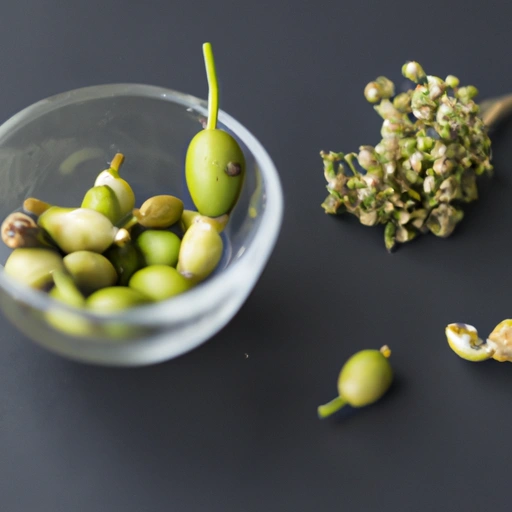Caper
Description

Capers are the unopened flower buds of the Capparis spinosa, a perennial plant native to the Mediterranean. After being picked, capers are typically cured in brine or packed in salt to draw out their unique, tangy flavor. Capers range in size from that of a small pea to that of a small olive, with the smaller nonpareil variety being the most prized for their superior texture and taste. In culinary contexts, capers lend a piquant sour-salty flavor to a variety of dishes, from sauces and salads to meat and seafood preparations.
Common uses
Capers are typically used in small quantities to add a burst of flavor to dishes. They are commonly found in Mediterranean cuisine, particularly in Greek, Italian, and French dishes. Capers are often used as a garnish or as an ingredient in sauces, dressings, and condiments. They can also be a key component in classic recipes such as chicken piccata, pasta puttanesca, and tapenade.
Nutritional value
Calories
Capres contain approximately 23 calories per 100 grams (3 1/2 ounces or about 2/3 cup).
Protein
Capres contain about 2.4 grams of protein per 100 grams.
Fat
Capers are low in fat, with only 0.9 grams per 100 grams.
Carbohydrates
They are composed of roughly 4.9 grams of carbohydrates per 100 grams.
Vitamins
Capers are a good source of vitamin K, providing about 24.6 micrograms per 100 grams, and they also have small amounts of vitamin C and B vitamins.
Minerals
The flower buds are rich in minerals, including iron, calcium, and copper, with about 1.7 milligrams of iron, 40 milligrams of calcium, and 0.1 milligrams of copper per 100 grams.
Health benefits
Capers are known for their antioxidant properties, thanks to the presence of flavonoids and phenolic compounds. They may have anti-inflammatory effects and contribute to heart health by improving cholesterol levels. The high vitamin K content in capers is essential for blood clotting and bone health.
Potential risks
Due to their high sodium content from the brining process, capers should be consumed in moderation, especially by individuals with hypertension or a salt-sensitive condition. Overconsumption may lead to excessive sodium intake. Additionally, capers may contain high levels of histamine, which can cause allergic reactions in sensitive individuals.
Common recipes
Capers are featured in numerous recipes, including salads like the French Niçoise, pasta dishes like Spaghetti alla Puttanesca, and meat dishes such as Veal Piccata.
Cooking methods
Capres can be rinsed and added directly to dishes or briefly sautéed to enhance their flavor. They're often used as a finishing touch to add complexity to a dish's flavor profile.
Pairing with other ingredients
Their tangy flavor pairs well with lemon, garlic, olives, tomatoes, and anchovies. Capers also complement the flavors of fish and poultry.
Summary
Capers are a small but mighty ingredient that can elevate the flavor of countless dishes with their unique, piquant taste. With a rich history and broad culinary applications, they continue to be a favorite in kitchens around the world. Despite their high sodium content, capers offer notable health benefits and can be a healthful addition to a balanced diet when used in moderation.